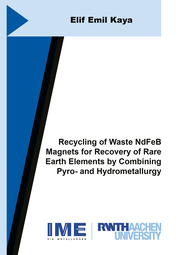Recycling of Waste NdFeB Magnets for Recovery of Rare Earth Elements by Combining Pyro- and Hydrometallurgy von Elif Emil Kaya
Recycling of Waste NdFeB Magnets for Recovery of Rare Earth Elements by Combining Pyro- and Hydrometallurgy
Schriftenreihe des IME 80
ISBN/EAN: 9783844089479
Sprache: Englisch
Umfang: 178 S., 55 farbige Illustr., 55 Illustr.
Einband: kartoniertes Buch
Erschienen am
17.03.2023
Auf Wunschliste
Rare earth elements (REEs) and permanent magnets are widely used in technological products and applications and form the basis for the new generation technology. REEs were added to the list of critical metals due to their increased demand and the associated supply risk. According to the report first published by the European Union Commission in 2011 and most recently in 2020, REEs are the ones with the highest supply risk among critical elements. The critical importance of REEs has brought about an increase in their efforts to ensure the sustainability of raw materials. Therefore, the recycling of NdFeB magnets, whose service life is completed or which are scrapped due to a process error, is the most effective alternative for the solution of the supply problem of their raw materials. Although many studies investigated the combination of hydrometallurgical and pyrometallurgical methods, there still remain some processing problems such as a multiple-stage process for high purity products, the use of high amounts of chemical agents for conventional precipitation and oxidation of iron, loss of high amounts of REEs during extraction. RE oxides are produced by oxalate precipitation, double salt precipitation, hydroxide precipitation methods after the iron is removed from the system. However, oxalate precipitation of REEs is not feasible economically and in the double salt precipitation method, the iron also precipitates with REEs, and the precipitation agents used such as sodium hydroxide, calcium carbonate, and sodium sulfate cause the impurity to come into the system and constitute an obstacle to the production of high purity products. Hence, in this dissertation, three flowsheets are proposed for unraveling the abovementioned problems with novel processing methods






